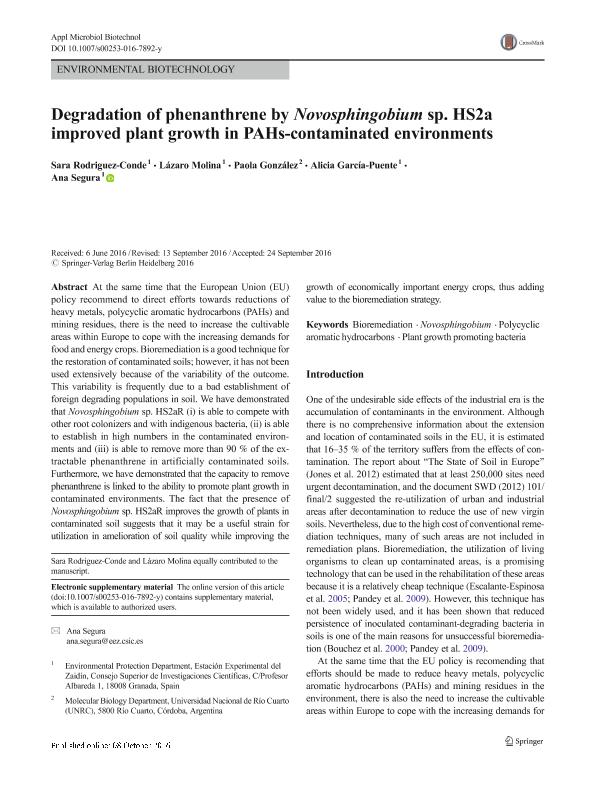Artículo
Degradation of phenanthrene by Novosphingobium sp. HS2a improved plant growth in PAHs-contaminated environments
Fecha de publicación:
09/2016
Editorial:
Springer
Revista:
Applied Microbiology and Biotechnology
ISSN:
0175-7598
Idioma:
Inglés
Tipo de recurso:
Artículo publicado
Clasificación temática:
Resumen
At the same time that the European Union (EU) policy recommend to direct efforts towards reductions of heavy metals, polycyclic aromatic hydrocarbons (PAHs) and mining residues, there is the need to increase the cultivable areas within Europe to cope with the increasing demands for food and energy crops. Bioremediation is a good technique for the restoration of contaminated soils; however, it has not been used extensively because of the variability of the outcome. This variability is frequently due to a bad establishment of foreign degrading populations in soil. We have demonstrated that Novosphingobium sp. HS2aR (i) is able to compete with other root colonizers and with indigenous bacteria, (ii) is able to establish in high numbers in the contaminated environments and (iii) is able to remove more than 90 % of the extractable phenanthrene in artificially contaminated soils. Furthermore, we have demonstrated that the capacity to remove phenanthrene is linked to the ability to promote plant growth in contaminated environments. The fact that the presence of Novosphingobium sp. HS2aR improves the growth of plants in contaminated soil suggests that it may be a useful strain for utilization in amelioration of soil quality while improving the growth of economically important energy crops, thus adding value to the bioremediation strategy.
Archivos asociados
Licencia
Identificadores
Colecciones
Articulos(CCT - CORDOBA)
Articulos de CTRO.CIENTIFICO TECNOL.CONICET - CORDOBA
Articulos de CTRO.CIENTIFICO TECNOL.CONICET - CORDOBA
Citación
Rodriguez Conde, Sara; Molina, Lázaro; González, Paola Solange; García Puente, Alicia; Segura, Ana; Degradation of phenanthrene by Novosphingobium sp. HS2a improved plant growth in PAHs-contaminated environments; Springer; Applied Microbiology and Biotechnology; 100; 24; 9-2016; 10627-10636
Compartir
Altmétricas




